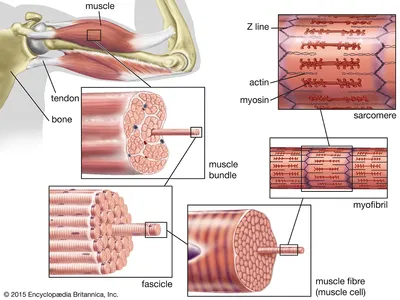Muscle
muscle, contractile tissue found in animals, the function of which is to produce motion.
Movement, the intricate cooperation of muscle and nerve fibres, is the means by which an organism interacts with its environment. The innervation of muscle cells, or fibres, permits an animal to carry out the normal activities of life. An organism must move to find food or, if it is sedentary, must have the means to bring food to itself. An animal must be able to move nutrients and fluids through its body, and it must be able to react to external or internal stimuli. Muscle cells fuel their actions by converting chemical energy in the form of adenosine triphosphate (ATP), which is derived from the metabolism of food, into mechanical energy.
Muscle is contractile tissue grouped into coordinated systems for greater efficiency. In humans the muscle systems are classified by gross appearance and location of cells. The three types of muscles are striated (or skeletal), cardiac, and smooth (or nonstriated). Striated muscle is almost exclusively attached to the skeleton and constitutes the bulk of the body’s muscle tissue. The multinucleated fibres are under the control of the somatic nervous system and elicit movement by forces exerted on the skeleton similar to levers and pulleys. The rhythmic contraction of cardiac muscle is regulated by the sinoatrial node, the heart’s pacemaker. Although cardiac muscle is specialized striated muscle consisting of elongated cells with many centrally located nuclei, it is not under voluntary control. Smooth muscle lines the viscera, blood vessels, and dermis, and, like cardiac muscle, its movements are operated by the autonomic nervous system and thus are not under voluntary control. The nucleus of each short tapering cell is located centrally.
General features of muscle and movement
Muscle powers the movements of multicellular animals and maintains posture. Its gross appearance is familiar as meat or as the flesh of fish. Muscle is the most plentiful tissue in many animals; for example, it makes up 50 to 60 percent of the body mass in many fishes and 40 to 50 percent in antelopes. Some muscles are under conscious control and are called voluntary muscles. Other muscles, called involuntary muscles, are not consciously controlled by the organism. For example, in vertebrates, muscles in the walls of the heart contract rhythmically, pumping blood around the body; muscles in the walls of the intestines move food along by peristalsis; and muscles in the walls of small blood vessels constrict or relax, controlling the flow of blood to different parts of the body. (The effects of muscle changes in the blood vessels are apparent in blushing and paling due to increased or decreased blood flow, respectively, to the skin.)




Comments
Post a Comment